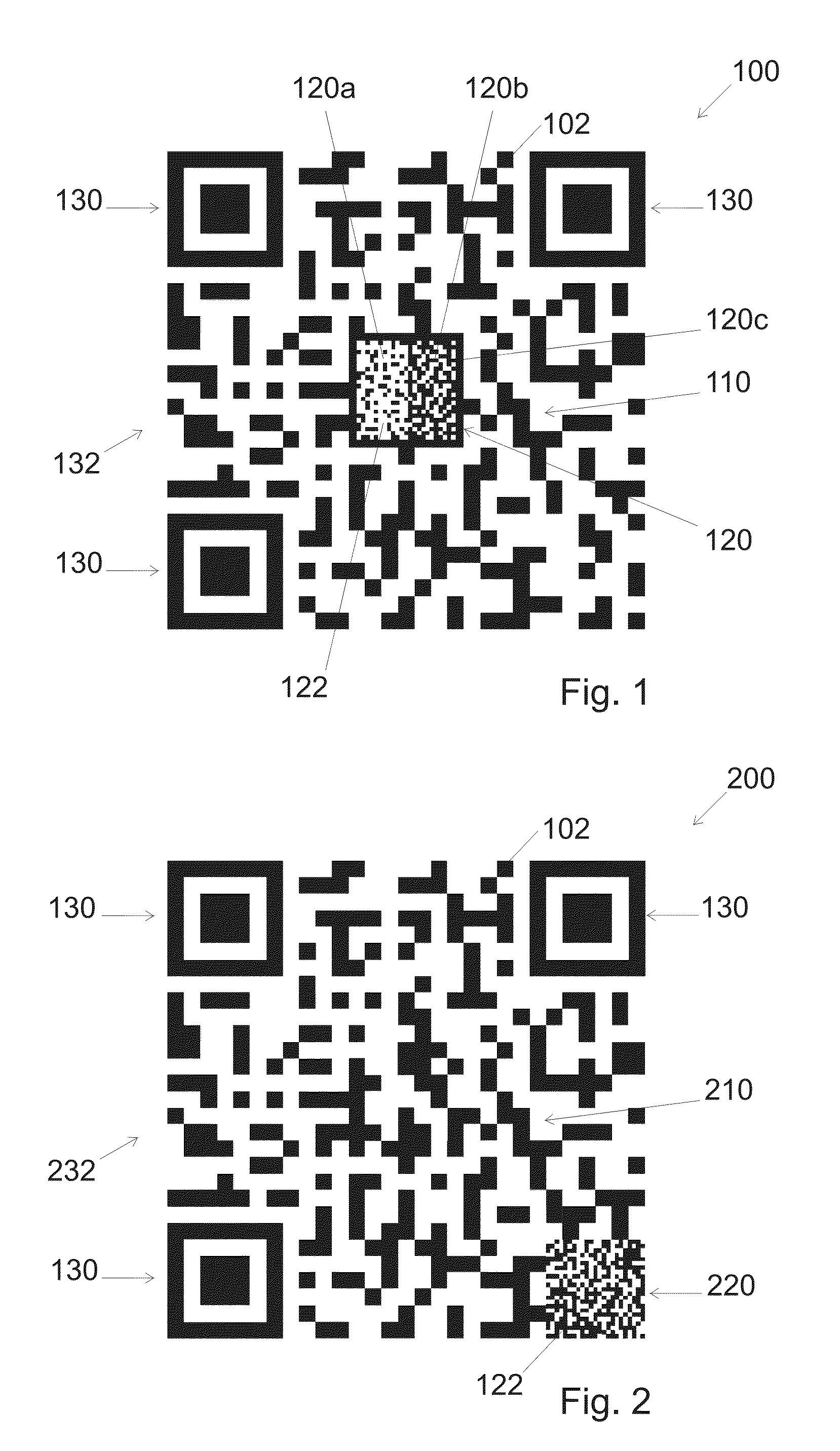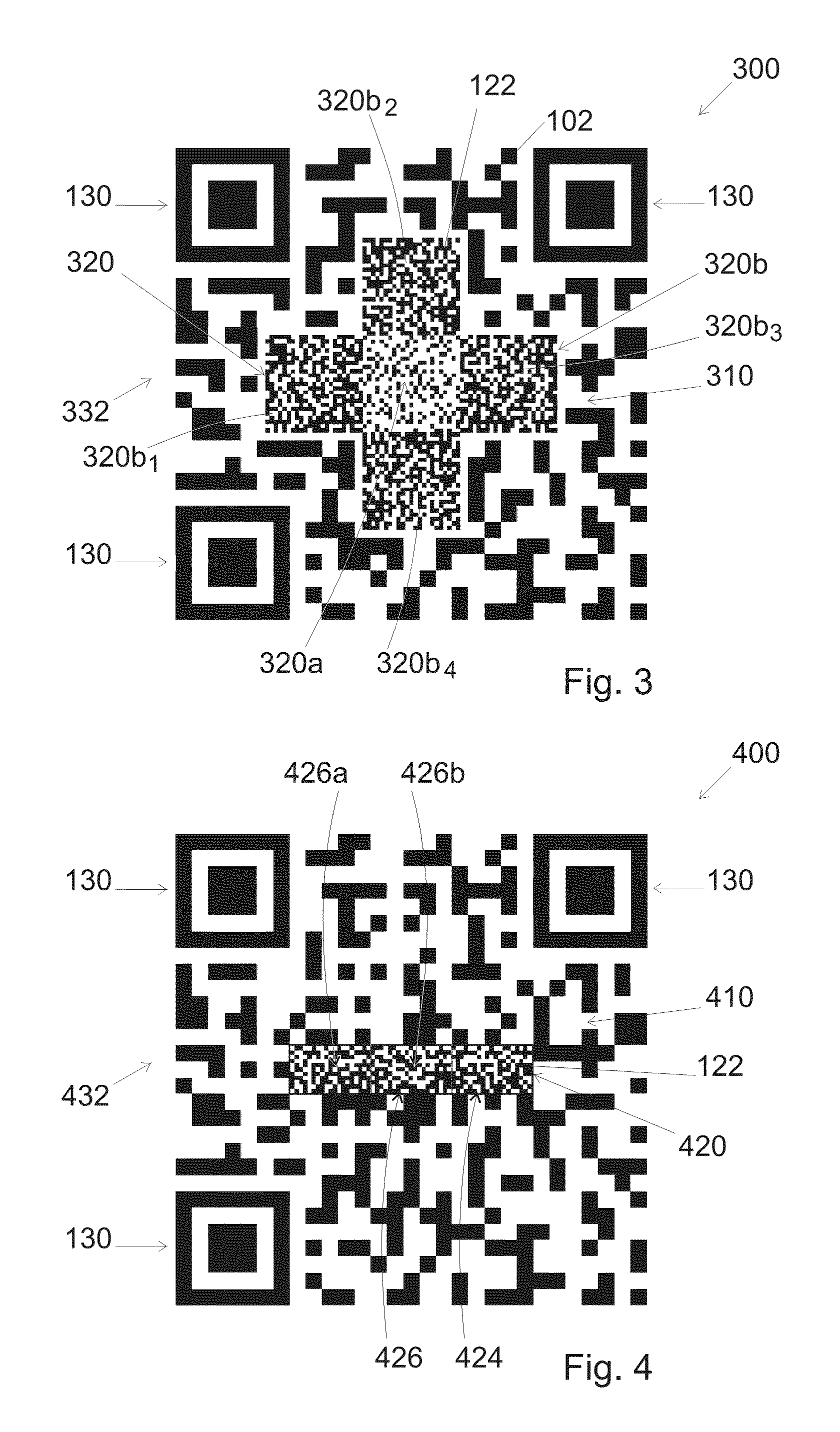Two dimensional barcode and method of authentication of such barcode
a two-dimensional barcode and authentication method technology, applied in the field of two-dimensional barcode and authentication method of such barcode, can solve the problems of easy copying or imitation, inconvenient verification, and inability to integrate or integrate production processes using all such methods, and achieve the effect of improving the security level of authentication of 2d barcod
- Summary
- Abstract
- Description
- Claims
- Application Information
AI Technical Summary
Benefits of technology
Problems solved by technology
Method used
Image
Examples
first embodiment
[0063]FIG. 1 shows a first example of a QR code forming a first embodiment for a 2D barcode 100 according to the invention. This 2D barcode 100 is formed by a symbol having a general square shape and comprising usual patterns of a QR code, namely three position detection pattern 130 located at three of the four corners of the QR code, and a data area 132. This data area 132 first includes primary information pattern 110 formed by a chosen arrangement of elementary cells 102, being here sets of 10×10 pixels, and shown in a non-limitative way as squares. These elementary cells 102 are coding primary information and have a size allowing most copying machines to copy the primary information pattern 110 without altering it or with such a little alteration that this pattern can be decoded correctly and there is no alteration to the information stored in the cells. Typical but non limitative size of elementary cells 102 coding primary information in the primary information pattern 110 of o...
second embodiment
[0074]FIG. 2 shows a second example of a modified QR code forming a second embodiment for a 2D barcode 200 according to the invention. The reference numbers used to describe this 2D barcode 200 are the same as for identical parts already shown in FIG. 1 and are increased by 100 for similar parts with respect of those of FIG. 1.
[0075]Here the symbol forming the modified 2D barcode 200 is formed by a square data area 232 containing three position detection patterns 130a, primary information pattern 210, and a visible pattern 220. In this second embodiment, secondary information is embedded by a visible pattern 220 which is not located in the center area of the square data area 232 but is located at the corner of the square data area 232 which does not contain a position detection pattern 130 (here at lower right corner). This situation does not disturb the position detection function of the three position detection patterns 130 since they stay at the same place and have not been modif...
third embodiment
[0077]FIG. 3 shows a third example of a modified QR code forming a third embodiment for a 2D barcode 300 according to the invention. The reference numbers used to describe this 2D barcode 300 are the same as for identical parts already shown in FIG. 1 and are increased by 200 for similar parts with respect of those of FIG. 1.
[0078]As for 2D barcode 100 of FIG. 1, the 2D barcode 300 of FIG. 3 contains a visible pattern 320 with secondary information which is centered within the primary information pattern 310, which means matching between the geometrical center of the visible pattern 320 and the geometrical center of the primary information pattern 310. In this third embodiment, the visible pattern 320 is formed by a square first portion 320a having a first low average black density or first low average level of grey and being centrally located inside the visible pattern 320, and a second portion 320b with a second high average black density or second high average level of grey and s...
PUM
 Login to View More
Login to View More Abstract
Description
Claims
Application Information
 Login to View More
Login to View More - R&D
- Intellectual Property
- Life Sciences
- Materials
- Tech Scout
- Unparalleled Data Quality
- Higher Quality Content
- 60% Fewer Hallucinations
Browse by: Latest US Patents, China's latest patents, Technical Efficacy Thesaurus, Application Domain, Technology Topic, Popular Technical Reports.
© 2025 PatSnap. All rights reserved.Legal|Privacy policy|Modern Slavery Act Transparency Statement|Sitemap|About US| Contact US: help@patsnap.com



